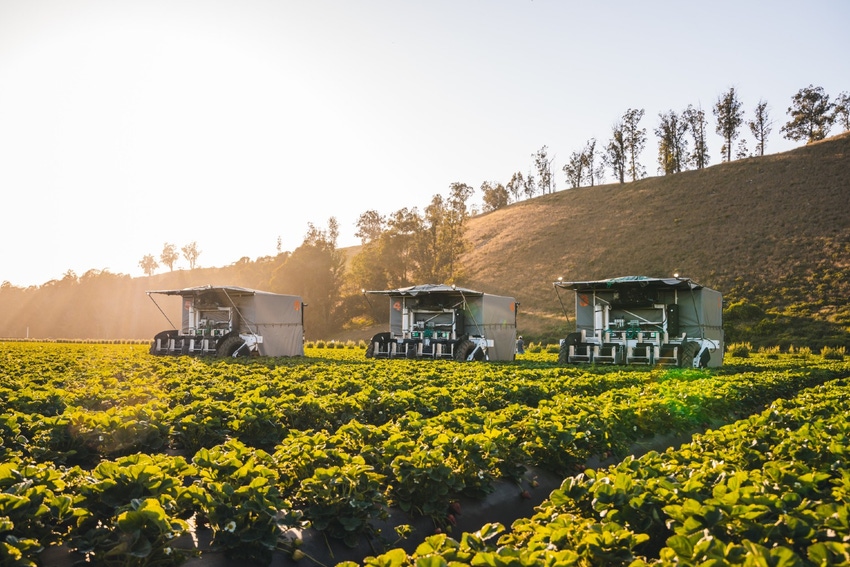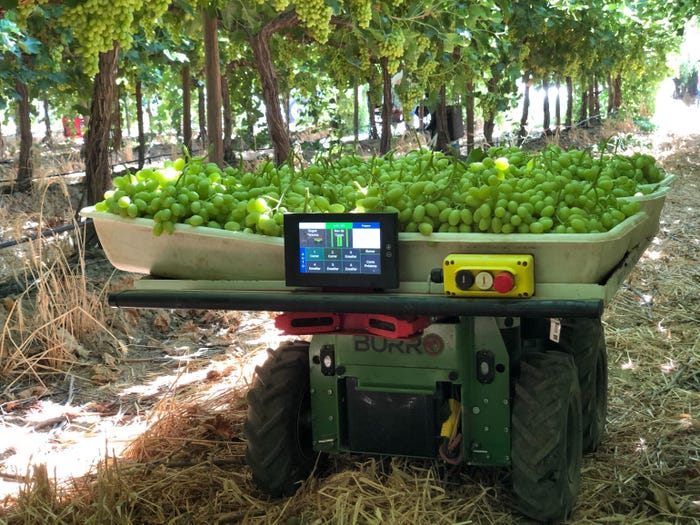
With the high cost and limited availability of labor, farmers are looking to a future where robotics may play a bigger role in the harvest of fruit, vegetable and nursery crops.
Robotics is still in the early stages, but a number of companies have found success in using robots to harvest crops such as table grapes and strawberries. At the virtual National AgTech Forum Jan. 13, sponsored by AgLaunch, AgStart and the North Carolina Biotechnology Center, representatives from two startup robotic companies shared their experiences in using robots to harvest crops.
Advanced Farm is a Davis, Calif.,-based company that has developed a robotic strawberry harvester, while Burro is a Philadelphia-based company that has developed a robot to assist workers in table grape harvesting.
At the virtual forum, Kyle Cobb, co-founder and chief financial officer of Advanced Farm, and Charlie Andersen, founder and chief executive officer of Burro, shared both the challenges and opportunities of using robots in agriculture.
Advanced Farm’s robotic strawberry harvester uses soft grippers and tractor-mounted cameras that are able to determine the ripeness of berries and safely harvest them without damaging the fruit. Right now, Advanced Farm’s robotic strawberry harvester is only used in California, where 90 percent of U.S. strawberries are produced.
The harvester is scalable when it is in the field with no driver needed. Cobb said the harvester has already been used to pick tens of thousands of berries and the chances are excellent that the strawberries consumers buy at grocery stores across the country were picked by a robot.
Cobb said there is strong demand for a robotic strawberry harvester because regulatory challenges, the minimum wage and overtime laws continue to put a great deal of cost pressure on growers. “What is always true about agriculture is it is really tough work with really tough jobs that frankly need to be automated,” he said.
Burro markets autonomous, rugged cart robots that follows farm workers in the field and can haul goods for them. The Burro has a 26-inch by 48-inch chassis and comes with a two-wheel and a four-wheel drive option. The two-wheel Burro can carry 300 pounds while the four-wheel Burro can carry up to 450 pounds. Burros are powered by sealed lead acid batteries, have a top speed of five miles per hour, and can travel up to 15 miles on a charge.
“Instead of building a harvesting vehicle today, we’re instead taking a stepped or phased approach beginning with people scaled collaborative robots that help people work right now and they are built in a way where they are very helpful,’ Andersen said.
“A six or eight- person crew using a single one of these Burro robots can be upwards of 40% to 50% more productive, which basically offsets one to two people each day per robot, creating an enormous amount of value,” he said.
Right now, the Burro is used exclusively in table grape production in California, but Andersen said the Burro can be used in blueberry, raspberry and nursery crop production. He said there is wide range of potential uses for the Burro.
Both Andersen and Cobb see the greatest potential for robots in fruit, vegetable and specialty crop production rather than in row crop production. Both are confident robots will play a bigger role in fruit and vegetable production due to the fact that labor challenges will only continue to grow with labor their No. 1 challenge.
“Field crops are already mechanized. There is very little opportunity to take labor out of that space. Eighty-eight percent of the U.S. crop workforce works in fruit, vegetable and nursery crops, and labor is about a quarter of revenue,” Andersen said.
“All table grapes in the United States are grown in a couple of counties in California. About $1.5 billion annually flows to labor; it is extremely labor intensive. The impact of the minimum wage and overtime regulations in California are driving the industry to the point where it’s only sustainable if it does adopt automation,” Andersen said.
Andersen believes that within 20 years the most labor-intensive areas of fruit and vegetable production will be automated. But he says there are still a lot of unknowns. He compares the ag robotics market to the personal computer market of the 1980s and 1990s.
“I perceive we are at a point in time that took place in the PC sector in the 1980s and 1990s, with standardization of form factors, universal operating systems that many people use, and an ecosystem built around it. That will happen in this space. I think there is an opportunity to build a people-scale platform that is collaborative today, but over time becomes a standard to which many other companies bring their autonomy, pull data off of or sell through to other entities as well,” Andersen said.

About the Author(s)
You May Also Like






